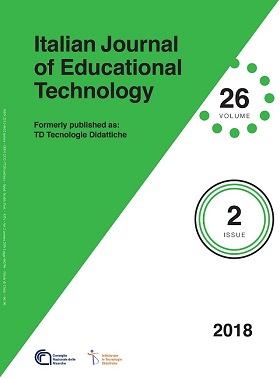Editoriale. Educational technology and Tangible-Intangible Cultural Heritage
Contenuto principale dell'articolo
Abstract
This issue of IJET includes a special dossier on Educational Technology and Tangible-Intangible Cultural Heritage. The decision to explore this topic was driven by the growing interest it is currently attracting both in Italy and abroad. This can be seen in numerous political initiatives and research projects in support of cultural heritage, especially in the area of education.
It is no coincidence the European Community has declared 2018 “The European Year of Cultural Heritage” . This move is designed to «encourage the sharing and appreciation of Europe's cultural heritage as a shared resource, to raise awareness of common history and values, and to reinforce a sense of belonging to a common European space» .
It’s worth pointing out here that the term cultural heritage covers all the cultural expressions of different peoples in different periods, including things like architecture and physical objects of various kinds, but also languages, folklore, traditions, artistic output, etc. These tangible and intangible expressions embody both our past and our future; they influence us as individuals and constitute a priceless treasure trove to preserve.
It comes as little surprise that, ever since the establishment of the 1972 World Heritage Convention, education has been recognised as a key factor for safeguarding and promoting cultural heritage. In recent decades, policies for the preservation and transmission of cultural heritage have been issued both in Italy and abroad, leading to the establishment of guidelines and funding programmes. To take just one example, each year Italy now issues an annual National Plan for Cultural Heritage Education. At European level, cultural exchange programmes like Erasmus+ have been in place for some time; in 2018 these efforts have been extended with a series of initiatives designed to raise awareness about cultural heritage among people of all ages and also to support the development and exchange of skills and know-how in this field.
Against this background, there has been growing interest in employing digital technologies to preserve cultural heritage. European Commission Recommendations 2011/711/EU highlight the need to digitalise cultural heritage so it can be enjoyed by a broader swathe of the community for both entertainment and educational purposes. This was the thinking behind Europeana , an EU-financed online portal that makes available a vast collection of digital resources in cultural heritage. In addition, the Horizon 2020 programme offered specific research funding opportunities in this area (EU, 2017).
Digital technologies are already being employed within (formal and informal) cultural heritage education. In recent years, research investigating new technology-driven opportunities has been intensifying. These efforts are reaching beyond simple digitalisation of digital heritage and looking into areas like virtual interaction and the scope for immersive experience of societies and cultures that are distant in both space and time. Prime examples include virtual and augmented reality applications, as well as videogames. At a major symposium called VideoGameLab recently held at Rome’s Cinecittà film studios, a special session was dedicated to the subject “Videogames, Research and Cultural Heritage” . The idea was to discuss the overlap between digital technologies, cultural heritage and scientific research.
Cultural heritage presents a number of new technological and methodological challenges that are of considerable interest in the educational technology field. The three contributions selected for this dossier not only examine the technological dimension of innovation, but also the methodological and pedagogical implications of designing and running technology-enhanced learning activities.[...]
Dettagli dell'articolo
Gli autori che pubblicano su questa rivista accettano le seguenti condizioni:
- Gli autori mantengono i diritti sulla loro opera e cedono alla rivista il diritto di prima pubblicazione dell'opera, contemporaneamente licenziata sotto una Licenza Creative Commons CC BY 4.0 Attribution 4.0 International License.
- Gli autori possono aderire ad altri accordi di licenza non esclusiva per la distribuzione della versione dell'opera pubblicata (es. depositarla in un archivio istituzionale o pubblicarla in una monografia), a patto di indicare che la prima pubblicazione è avvenuta su questa rivista.
- Gli autori possono diffondere la loro opera online (es. in repository istituzionali o nel loro sito web) prima e durante il processo di submission, poiché può portare a scambi produttivi e aumentare le citazioni dell'opera pubblicata (Vedi The effect of Open Access).
Riferimenti bibliografici
European Commission (2017). Mapping of Cultural Heritage actions in European Union policies, programmes and activities. Retrieved from http://ec.europa.eu/assets/eac/culture/library/reports/2014-heritage-mapping_en.pdf

